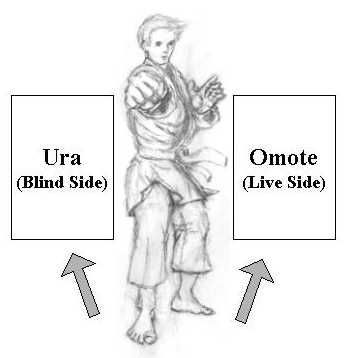 |
|||||
|
©™
2003 - 2008: OWH International - Ueshiba Aikido : Victoria, Canada All Rights Reserved |
|||||
|
|||||
All Aikido techniques have at least two sides or directions in its application. Students would have to be well-versed in both, on top of being able to perform techniques with both the right and left hands. I am aware that some students are confused by this, and what the differences are between the two directions, when executing a technique.
The two sides, or versions, of a technique are frequently referred to as "Omote" and "Ura". "Omote" (oh-moh-tay) literally means "surface", or the visible face of something. "Ura" (oo-rah) literally means "reverse", or the other (hidden) side. When performing a technique in "omote", the performer (Tori) moves into the "live" or active side of the opponent (partner/uke). Remember to execute an "atemi" into your partner's (uke) face to distract; leaving you with an opportunity to execute the lock and pin, or throw. When performing a technique in "ura", the performer (Tori) moves around to the "blind" side of the opponent (partner/uke). Sometimes, for easy reference during class, I refer to this direction as turning away from the attack, and being "back-to-back" with your partner. Moving in "ura" also serves to unbalance your partner on that "blind" side, causing them to fall either sideways or backwards. Note that it is important to follow through completely in either direction. When turning away from your partner, going into "ura", continue turning in a circular fashion in that direction until the pin, or throw, is executed. To fully turn away from and move behind your partner, onto the "blind" side, you will need to either execute a proper "Irimi" movement, stepping deep, into the back of your partner, or a full "Tenkan", drawing your back leg fully to the rear, causing you to be literally back-to-back with your partner. When entering directly into "omote", continue forward, stepping deep into the centre of your partner to unbalance, and on until the pin, or throw, is executed. While the above refers to moving in a certain direction, there are distinct differences in executing a technique in either "omote" or "ura". Similarly, taking proper "Ukemi" in either direction is different. Please pay attention to the footwork, arm extensions, and the proper application of each technique and "ukemi" when I am demonstrating them during classes. Thorough familiarity with both "omote" and "ura" forms in each technique will allow you to readily switch confidently between the two, should you need to, during free-form randori and jiyu waza in your upper grades. Keep your mind free of distractions during a technique demonstration, and alert to any detail that you had not noticed before. If in doubt, or uncertain about each form, please do not hesitate to ask. Proper preparation in your lower grades will allow you to enjoy more complex techniques, and keep you free from injury in your later years, in the higher grade levels. See you in the Dojo. In
peace and harmony, |
|||||
|
©™ 2003 - 2008: OWH International - Ueshiba Aikido : All Rights Reserved |
|||||
